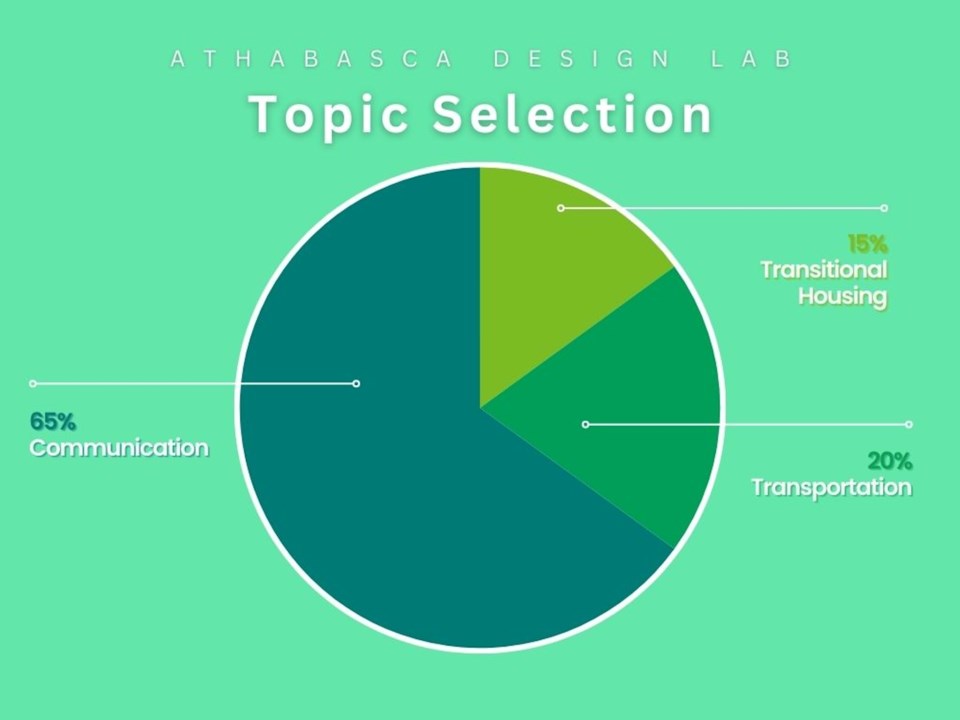ATHABASCA — Community co-designers are one step closer to creating a solution to communication gaps in Athabasca after more in-depth discussions and two voting rounds took place during the latest Design Lab session.
On April 18, Athabasca University’s Academic Research Centre was filled with more than 15 locals with a common goal: increasing information-sharing between residents, groups, and organizations in the area to foster greater feelings of belonging in the community by addressing issues of power, access, awareness, and connection.
“I feel like we made a lot of really significant progress today,” said Kelsey Brown, project designer with The Social Impact Lab Alberta.
“Coming from 15-plus pages of good ideas, adding to that, and then ending up with four really strong ideas on how to improve communication in Athabasca, it feels good,” she added.
The meeting — which saw a few new faces join the designing process, along with many regulars — began with creative cognitive warm-up exercises issued by Brown and Calgary United Way service designer Beth Ed.
After brainstorming the worst thinkable ideas to improve communication in Athabasca and flipping them, and expanding on good suggestions from previous sessions, designers made major moves towards the goal of the lab: a community-informed and supported solution and a one-time grant of $10,000 to see the initiative implemented.
Participants voted twice to narrow down the list of ideas and potential solutions curated throughout the seven-month process thus far. After the first round, six solutions were selected as most popular, and a second vote whittled that list down to four: A community gallery that would function as an information, connection, and local curation hub; a community coordinator who would facilitate connections and communication between community groups and organizations; interactive tablets in high-use areas with Athabasca-specific information; and regular community-wide events hosted in public spaces to enrich community connections.
Local input
Now with a shortlist of four potential solutions, designers will be seeking feedback from community members at large next month. Due to a cancelled session in March thanks to a snow storm, the lab will have two meetings in May.
On May 2, participants will begin prototyping their ideas, and a mid-May session will see those prototypes tested by the people who may use them in the future.
“Having community input is everything,” said Brown. Prototypes will be tested using three ‘lenses’ of design analysis: desirability — is it a wanted solution? Feasibility — can it be done in the context of Athabasca? And viability — will it stand the test of time?
“Testing with the community and getting that feedback informs whether or not our product meets those three lenses,” she added. “We might think something’s a really great idea within the design lab, and we need to find out from the community if that’s actually true.”
The details for the community-testing session are not yet set in stone, as the labs desire to reach as many Athabascans as possible. Brown and Ed are considering hosting the meeting later than the usual 9 a.m. on the third Thursday of the month.
“It’s really important that we have a lot of diversity and a lot of different people in the community representing different communities or backgrounds to get their input, and make sure we’re not pushing forward an idea that isn’t what the community needs,” said Brown.
Brown said while designers are getting excited about the fruits of their labours nearing fruition, open minds and open ears are a crucial part of the final stages of the process.
“What we always say is we can’t fall in love with an idea, because it will change — as we get feedback from others in the community, as we bring this outside the walls of the Design Lab, people are going to share things that are going to change what our idea looks like, and we have to be open to that,” said Brown.
Check back on TownandCountryToday.com for more information on the date, time and location of the mid-May Design Lab community feedback session.


